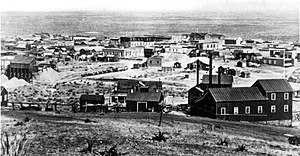
Back النزاع المسلح في أو كيه كورال Arabic Престрелка в Окей Корал Bulgarian Tiroteig de l'O.K. Corral Catalan Přestřelka u O. K. Corralu Czech Skudduellen ved O.K. Corral Danish Schießerei am O. K. Corral German Pafado ĉe la O.K. bovkorto Esperanto Tiroteo en el O.K. Corral Spanish O.K. Corrali tulevahetus Estonian O.K. Corraleko tiroketa Basque
| Gunfight at the O.K. Corral | |||||
|---|---|---|---|---|---|
 Tombstone in 1881 | |||||
| |||||
| Participants | |||||
|
| |||||
| Casualties and losses | |||||
| 3 wounded | 3 dead | ||||
| O.K. Corral gunfight |
|---|
| Principal events |
| Lawmen |
| Outlaw Cowboys |
The gunfight at the O.K. Corral pitted lawmen against members of a loosely organized group of cattle rustlers and horse thieves called the Cowboys on October 26, 1881. While lasting less than a minute, the gunfight has been the subject of books and films into the 21st century. Taking place in the town of Tombstone in Arizona Territory, the battle has become one archetype of the American Old West. The gunfight was the result of a long-simmering feud between five outlaws (including two sets of brothers) and four representatives of the law, including three brothers. The trigger for the event was the local marshal's decision to enforce a city ordinance that prohibited the carrying of weapons into town. To enforce that ordinance, the lawmen would have to disarm the Cowboys.
Among the lawmen were three brothers, Virgil, Wyatt, and Morgan Earp, as well as Wyatt’s close friend Doc Holliday. As Deputy U.S. Marshal and Town Marshal, Virgil was in charge, and it was his decision to enforce the ordinance that led to the shoot out. His two brothers and Doc Holliday were temporary assistant marshals.[1][2][3]
The Cowboys were a loosely-connected group of outlaws. In Tombstone at the time of the gunfight were five members of the Cowboys: Billy Claiborne, brothers Ike and Billy Clanton, and brothers Tom and Frank McLaury.
During that brief battle, three men were killed, three were wounded, two ran away, and one fought but was unharmed.
The gunfight was not widely known until two years after Wyatt Earp's death, when Stuart Lake published his 1931 Wyatt Earp: Frontier Marshal.[4] The book was the basis for the 1939 film Frontier Marshal, with Randolph Scott and Cesar Romero, the 1946 film My Darling Clementine, directed by John Ford,[4] and the 1957 film Gunfight at the O.K. Corral, after which the shootout became known by that name. Since then, the conflict has been portrayed with varying degrees of accuracy in numerous Western films and books, and has become an archetype for much of the popular imagery associated with the Old West.
Despite its name, the gunfight did not take place within or next to the O.K. Corral, which fronted Allen Street and had a rear entrance lined with horse stalls on Fremont Street. The shootout actually took place in a narrow lot on the side of C. S. Fly's photography studio on Fremont Street, six doors west of the O.K. Corral's rear entrance. Some members of the two opposing parties were initially only about 6 feet (1.8 m) apart. About thirty shots were fired in thirty seconds.[5] Ike Clanton subsequently filed murder charges against the Earps and Holliday. After a thirty-day preliminary hearing and a brief stint in jail, the defendants were shown to have acted lawfully.
The gunfight was not the end of the conflict. On December 28, 1881, Virgil was ambushed and maimed in a murder attempt by the Cowboys. On March 18, 1882, a Cowboy fired from a dark alley through the glass door of Campbell & Hatch's saloon and billiard parlor, killing Morgan. The suspects in both incidents furnished alibis supplied by other Cowboys and were not indicted. Wyatt, newly appointed as Deputy U.S. Marshal in Cochise County, then took matters into his own hands in a personal vendetta. He was pursued by county sheriff Johnny Behan, who had received a warrant from Tucson for Wyatt's killing of Frank Stilwell.
- ^ Correa, Tom (November 27, 2012). "Gunfight at the OK Corral – The Aftermath – Part One". Archived from the original on May 18, 2015. Retrieved May 16, 2015.
- ^ "Virgil Earp: In a Brother's Shadow". HistoryNet. March 23, 2018.
- ^ "This Civil War vet was the real hero of the O.K. Corral shootout". May 18, 2020.
- ^ a b Goodman, Michael (2005). Wyatt Earp. The Creative Company. p. 95. ISBN 1583413391. Archived from the original on May 18, 2016.
- ^ "Shootout at the OK Corral". History Channel. Archived from the original on March 20, 2016. Retrieved April 5, 2016.